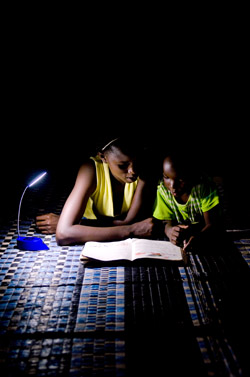Barefoot Power’s Lighting Project Registered for Carbon Finance
 As part of its mission to provide 10 million people with clean affordable lighting by 2015, Barefoot Power has successfully registered its Program of Activities under the UN Clean Development Mechanism.
As part of its mission to provide 10 million people with clean affordable lighting by 2015, Barefoot Power has successfully registered its Program of Activities under the UN Clean Development Mechanism.
This will allow Barefoot Power to turn the ‘kerosene savings’ achieved by using its solar lanterns into carbon credits.
“Carbon finance and carbon credits have been mentioned with regards to solar lighting projects for a long time, but it has historically been too complicated, costly and inefficient to capture for companies like Barefoot Power who distribute an extensive product line over many continents,” says Andrew Barson, Product Manager at the company.
The solar lantern manufacturer and distributor can then sell accrued carbon credits on the carbon market realizing revenue and use it to advance its activities towards its clean energy goal.
Barefoot Power envisions using revenues generated from trading its carbon credits to improve on the affordability and quality of its solar lighting products, and after sales service.
“Using the carbon project Barefoot Power can account for the greenhouse gas savings its products make and then use that revenue to ensure our products and services are accessible in the areas they are needed most,” says Barson.
Quality affordable solar lighting positively impacts education, health, income generation and reduced expenditure on kerosene such that carbon credits are so much more than just a saving in greenhouse gas emissions.
The project is the first Program of Activities to be registered under the Clean Development Mechanism where replacement of kerosene with solar lighting has been recognized for reducing climate change.
Computations by Lighting Africa show that adoption of solar lighting by about 4m people in Africa in the past three years has averted 78,000 tons of climate altering green house gases, the equivalent of removing 15,000 vehicles from the road.
Barefoot Power will now expand its activities into 22 countries where the company is currently marketing its range of solar products.
For more information on projects under consideration for CDM financing, visit our 2012 conference website www.lightingafrica.org/2012conference to see the UNFCCC presentation.
You can also find an article ‘From Carbon to Light’ on a new framework of estimating green house gas reductions or savings as a result of adoption of clean off-grid lighting products on LuminaNet https://light.lbl.gov/light.html.
The UN Framework Convention on Climate Change (UNFCCC) has also recently published the latest version of the CDM Methodology Booklet.

